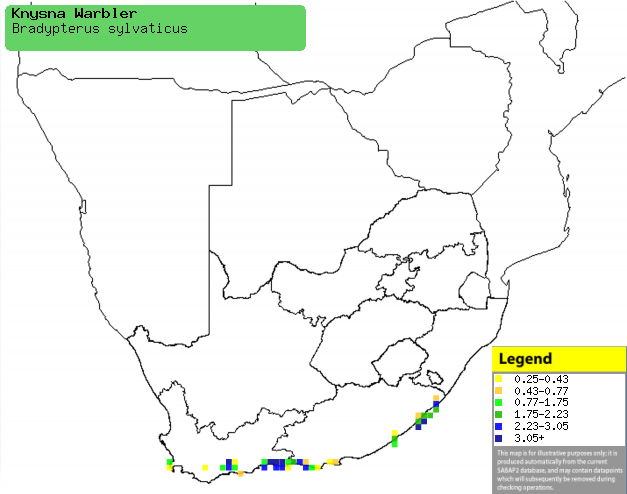|
Bradypterus sylvaticus (Knysna
warbler)
Knysnaruigtesanger [Afrikaans]; Kaapse struikzanger
[Dutch]; Bouscarle de Knysna [French]; Sundevalls buschsänger [German];
Felosa de Knysna [Portuguese]
Life
> Eukaryotes >
Opisthokonta
> Metazoa (animals) >
Bilateria >
Deuterostomia > Chordata >
Craniata > Vertebrata (vertebrates) > Gnathostomata (jawed
vertebrates) > Teleostomi (teleost fish) > Osteichthyes (bony fish) > Class:
Sarcopterygii (lobe-finned
fish) > Stegocephalia (terrestrial
vertebrates) > Tetrapoda
(four-legged vertebrates) > Reptiliomorpha > Amniota >
Reptilia (reptiles) >
Romeriida > Diapsida > Archosauromorpha > Archosauria >
Dinosauria
(dinosaurs) > Saurischia > Theropoda (bipedal predatory dinosaurs) >
Coelurosauria > Maniraptora > Aves
(birds) >
Order: Passeriformes > Family: Sylviidae
> Genus: Bradypterus
 |
|
Knysna warbler, Kirstenbosch Botanical Gardens,
South Africa. [photo Trevor Hardaker ©] |
Distribution and habitat
Endemic to South Africa, only occurring patchily along the
southern coast from Cape Town to Mbumbazi Nature Reserve, KwaZulu-Natal. It
generally prefers densely tangled undergrowth, often at the edge of temperate
forest or thickets of alien trees such as Cherry-pie (Lantana camara) and
brambles (Rubus).
|
 |
|
Distribution of Knysna warbler in southern Africa,
based on statistical smoothing of the records from first SA Bird Atlas
Project (©
Animal Demography unit, University of
Cape Town; smoothing by Birgit Erni and Francesca Little). Colours range
from dark blue (most common) through to yellow (least common).
See here for the latest distribution
from the SABAP2. |
Food
It eats a variety of invertebrates, doing most of its
foraging on the ground, upturning leaves and debris in search of prey. It could
be mistaken for a mouse, is it scurries across the ground with its body low down. The following food items have been recorded
in its diet:
Breeding
- The female solely builds the nest (see image below), which is a
thick-walled cup built of dry grass and narrow-bladed leaves, constructed on
a platform of dead and dying leaves and lined with finer plant material.
 |
|
Knysna warbler at nest with chicks. [photo Peter Steyn
©] |
- Egg-laying season is from September-November.
- It lays 2-3 eggs, which are incubated solely by the female for about
16-19 days. The female goes on regular foraging trips, while the male sits
on a nearby perch singing.
- The chicks are fed by both parents, who if threatened by predators try
to distract them away from their young.
Threats
Vulnerable, as its population in the Western Cape
has halved since the 1980s. Today its total population is thought to be in the
10 000s, but even this estimate may be optimistic. It is probably caused by the
burning of firebreaks at the edges of forests, coupled with reduced frequency of
bushfires, leading to forest expansion. When a forest becomes shaded by to many
trees, it moves out as it prefers dense bush, which cannot grow in such low
light conditions. In recent years it has resorted to living in woodlands invaded
by alien plants, and most have left from indigenous woodland.
References
-
Hockey PAR, Dean WRJ and Ryan PG 2005. Roberts
- Birds of southern Africa, VIIth ed. The Trustees of the John Voelcker
Bird Book Fund, Cape Town.
|
